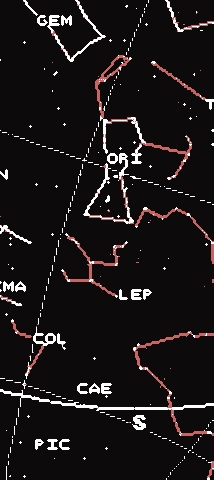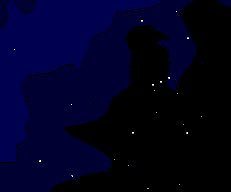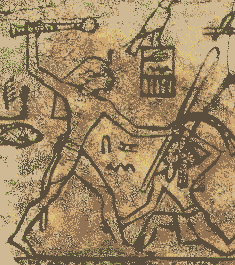Orion's Belt: Was this in fact Orion's Penis?
An addendum to Robert Bauval's Theory on Orion, Sirius, and the Great Pyramid
© Rae West 1998, 1999
Summary: This short article makes a case for what's now called Orion's belt in fact having been perceived by the ancient Egyptians (or at least the priestly ones) as a penis. As I'll show, this fits very well with the theories originating with Robert Bauval as to the function of the Great Pyramid, the so-called pyramid of Cheops.

Robert Bauval was the first known person to suggest that the groundplan of the three Giza pyramids and their relation to the Nile and some other pyramids imitated Orion's belt, the Milky Way, and some other stars in Orion.
Bauval and Hancock maintain (I think; my information's from a lecture) that in 2450 BC, a month before the spring equinox, the sun rose (in the east) after Leo had risen between the paws of the sphinx. And, in the southern sky, Orion was simultaneously positioned with its belt at exactly 45 degrees to the horizon. These and other alignments are explained by Bauval and Hancock as being involved in a ceremony involving the dead Pharaoh, whose essence or soul (in Egyptian) was, they say, believed to be expelled through one of the four shafts from the Great Pyramid, to become permanently resident as a star. The 'opening of the mouth' ceremony was part of this.
This illustration shows Orion (Sah, apparently, to the Egyptians) as it would appear in 2450 BC - though I have to confess my Skyglobe gives it an impossible afternoon time.
The Egyptians' perception of this part of the sky was different from ours; Duat was Orion plus Sirius, and other stars, considered as a mobile unit; Sirius was called Sopdet, a goddess, later Graecised/Romanised to Sothis.

The phallic motif seems to have been strongly present in Egypt (though of course largely censored by the Victorians and more modern archaeologists). Min, or Amun-Min, one of the manifestations of the ram god, is the outstanding example.

After all, what's so fascinating about a belt? Why build an elaborate shaft from the King's chamber to look at a belt?
This shows the painted interior of a sandstone shrine or chapel at Deir el-Bahari/Der el-Bahri, dedicated by Tuthmosis III to the cow goddess Hathor. The king makes an offering to Amun (or Amun-Ra - accounts vary!). I'd draw your attention to the triangular skirt or kilt of the king; this shape was fashionable for a long while and is frequently shown being worn (e.g. by Tutankhamun). Is it possible this is a reflection of Orion's shape? Perhaps the triangular shoulder arrangement represents Orion too. One might also speculate about the nature of the offering depicted here. |
 |
 |
Incredibly durable image (left): this shows ‘King Den smiting an Asiatic’, dated by the British Museum at about 3000 BC. Virtually identical images occur in Ptolemaic times, e.g. at Edfu, dated about 70 BC. Possibly based on the Orion (and Hercules) image. However, the ancient Egyptians seem to have recorded no accurate star diagrams; if so, it's impossible to be certain how they interpreted the star patterns they saw.  |
Some information here is taken from a talk by Bauval and Hancock at Waterstone's Bookshop, Canterbury, 29 May 1996. Also from several books jointly-authored by Bauval. There's a TV programme on the subject, introduced not inappropriately by Emma Freud, first shown in 1994, with Robert Bauval and Adrian Gilbert, of The Orion Mystery. I should make it clear that 'Duat' meant something like the Underworld in Egyptian; Bauval and Hancock say the same word applies to a section of the sky. I'm pleased that Bauval & Gilbert and others did their astronomical work; but I ought to add that, of course, I have reservations about it.
NB: the supposed superimposition of the three stars of the belt with the apexes of the pyramids looks slightly unconvincing, with the stars shown overexposed, suggesting the fit mightn't be as good as is implied. If somebody checks this, could he/she also see whether the original version of the phrase ‘Orion's belt’ has an ambiguity or possible other meaning? Thanks. Incidentally this piece is meant entirely seriously.
E-Mails
Wayne Hay [July 98] e-mailed: 'Rae West asks if the belt might be a penis....well it probably is....because one of the functions of the Pharaoh on special holy days was to enter the Temple and ritually masturbate....this was treated recently by an archaeological presentation on educational television....and since generation was through the essence of the god, all creation was supposed to have sprung from the god in this way....refer to masturbation as a sacred art in Egyptian religious hierarchy...' [His dots-RW]Yes, I was delicately hinting at this. I think you may mean a BBC 'Timewatch', titled 'Karnak, a Hidden History', with voiceover by Andrew Sachs, better known as Manuel of 'Fawlty Towers'. The huge set of buildings at Karnak may have had such a ceremony in its inner 'sanctum', a masturbation ceremony supposedly related to the daily copulation of the sun with his mother the moon, plus an annual boat ride by the Pharaoh to sister smaller temple at Luxor. But the ceremony very secret, and these things were never written down. The evidence appeared to be a woman, the wife of god, translated also as 'the hand of god', suggesting a masturbation link; someone (Osiris?? - I forget) 'making love to his fist'. The images found (none in Karnak) naturally were subject to censorship by the Victorians.
Stephen R Wilk of Saugus, MA, April/May 1999: '.. Orion's Belt being a penis. I must congratulate you on this discovery, which I believe to be correct. ... [my dots-RW] I originally believed that the "sword" of Orion represented his penis, but your explanation of the belt being the penis is a far better explanation (even though proposed for the case of Egyptian Osiris), and fits in very nicely with my interpretations of the astronomical significance of the myth of Orion. I can provide further detials if you are interested.'
I haven't received further details, but Stephen Wilk's interest is ancient Greek mythology and variable stars, suggested by a 1979 piece by a Prof. Lettvin of MIT: 'This is a connection I think most people have overlooked. I have a book forthcoming on the topic. "Medusa: Solving the Mystery of the Gorgon" is coming out in December of 1999 from Oxford University Press, and deals with connections between the constellations of Perseus, Andromeda, Cepheus, Cassiopeia, Pegasus, and Cetus with the myth of Medusa and Perseus.'
Wilk's idea is that 'the variability of Algol was known in pre-classical Greece, and that knowledge of the period is reflected in the myth of Perseus. Moreover, knowledge of the variability of Algol, Mira, delta Cephei, and gamma Cassiopoeia accounts for all their parent constellations being associated in the same myth as antagonists of Perseus.' His book is not yet published, but the sample he sent me includes the suggestion that the immortality of two of the three gorgons corresponds with the two bright days of Algol, the third, eclipsed, day [of its 70 hour period] being represented by Medusa. The Perseid meteor shower 'appears to originate from the arm of the constellation of Perseus. It is very easy to see in the display Perseus hurling the eye of the Graeae into Lake Tritonis.' Wilk has many interesting related ideas: 'the most peculiar image associated with the myth—the birth of Chrysaor and Pegasus from the neck of Medusa.. [can be explained by] the constellations of Perseus (with Medusa's head) and Pegasus. If we interpret Hesiod's words to mean that Pegasus and Chrysaor sprang from the stump of the neck attached to the head, rather than from the stump attached to the body, then the scene is pictured in that grouping of stars.'
Comments: I have a few miscellaneous suggestions which may or may not be original—I'm not sure:
[1] It strikes me one of the purposes of myths may have been as a mnemonic in memorising star patterns. Personally I think—you may disagree—many of the constellations have such vague outlines that they could be redrawn arbitrarily (especially the long sinuous ones). There are exceptions, like Cassiopeia and I suppose the bears. However, in a period when reading the stars was an important navigational device, it would make sense to pass on the interpretation in the form of stories, rather than just listing the patterns and flatly stating which is which. Also of course it's more memorable to give them striking and anthropomorphic names. So myths may have had a serious teaching purpose, which nobody took literally.
[2] On the same subject, I wondered whether you've looked into cross-cultural attitudes to the stars? Possibly there are completely different collections of stars used e.g. in Mongolia. For that matter, I wouldn't be surprised if e.g. mariners at one time emphasised different stars from land-based people. However, I admit this is very difficult to study!
[3] As I understand it, although nobody seems to word it like this, the Egyptians used stars as a sort of clock—Sirius rising being so to speak a large example; on a daily basis other stars were used to time what we'd call 4 hours, or 6, or whatever. So they may have had a different idea of what a constellation is—i.e. a string of bright stars stretched out like a long necklace with just a few things on it, different from our localised clump of stars.
'.. if you look into the astronomies of other cultures you usually find the constellations are very different. One of the headaches of this sort of study is finding the constellations of other cultures set down anywhere. .. In most cases we don't really know what the constellation looked like. Even for the case of Egyptian constellations, for which we have many depictions, the identification of actual star patterns with constellation names is still tentative..
In some cases the constellations suggest a form, so we can see why the ancient people gave it the name they did, or the attributes they did. One particularly clear case is that of Taurus. The "V" shape defined by the Hyades pretty clearly suggests the horns of a bull. Another case is Scorpio, where the J + T shape of the stars suggests a scorpion's coiled stinger. .. Curiously, one case of interest to us both shows that our expectations are not always fulfilled. The constellation of Orion seems clearly defined, with the large rectangle of stars, marked by the three stars of the belt/penis. Yet most cultures do not consider the four stars of the rectangle part of the constellation at all! The three "belt' stars are seen as an arrow, or as cooking fires, or some such figure, and Betelgeuse, Rigel, Bellatrix are not even considered. This, by the way, is one reason I find Bauval's pyramid thesis convincing -- considering the belt apart from the other stars as a constellation is the way most of the world sees the constellation.'
24th April 2000: Stephen Wilks has set up a website www.medusamystery.com (this may no longer exist).
Disclaimer: I noticed, in Feb 1999, that 'Orion' is occasionally used as an acronym for a slogan 'Our Race is Our Nation', an obviously inaccurate claim (except perhaps for the Chinese?) At any rate, no racial significance was or is intended by this article - RW [writing in 2000]
Top of this page
Click for Index to all my general interest items collected in one file
Click for Home page of entire big-lies.org site
HTML Rae West. First uploaded 98-04-08 revised 98-04-30, 2000-05-25. Cerne added 96-06-15. Emails 99-09-24. Wilks link 2000-04-24. Re-uploaded as standalone file (reformatted) 2016-07-30